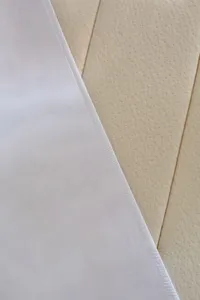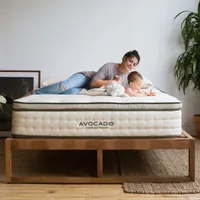How do I know if my mattress contains fiberglass? These experts explain why it matters
If you want a mattress that's better for both the environment and your health, you might want to avoid ones containing fiberglass


How well do you know your mattress? Chances are, not very well at all; and yet, you share eight hours with it every night. In recent years, we've all made a conscious effort to choose environmentally-friendly mattresses that are more easily recycled or made with organic materials. We're familiar with all the main culprits, such as memory foam, but did you know your mattress could also contain fiberglass?
That's right, that fluffy-looking insulating material that you should only handle when wearing a mask and gloves could be hiding inside your mattress. The malleable and durable material is commonly used as a fire retardant - especially in foam mattresses - and, as such, the potential health risks are widely debated. But how do you know if your mattress contains fiberglass when choosing the right mattress?
Thanks to the help of some experts we have the answer, as well as an insight into whether fiberglass is actually a safe material to share your bed with after all...

Lilith is an expert at following news and trends across the world of interior design, and she regularly uses her expertise to share articles that help readers make the safest (and most stylish) choices in their homes. For this piece, she spoke with experts on bedding and mattresses to learn how to find out whether there's fiberglass in your mattress and the implications.
What is fiberglass?
Before we jump into the nitty-gritty, it's worth knowing a bit more about what fiberglass actually is. If you're not familiar with it, fiberglass is basically a composite material made of glass and reinforced plastic that's usually manufactured in sheets that are commonly used as an insulating material.
Its soft, malleable properties also make it a cheap option when it comes to making mattresses. 'It's sometimes found in mattresses made in the US as it’s a cheap fire retardant option,' explainsbed specialist Jonathan Warren, director at Time4Sleep. 'But, upon direct contact, it can pose several potential health hazards, including skin, eye, and respiratory irritation.'
For a safer night's sleep that's better for you and the planet, try the Natural Mattress from Birch. Their organic mattresses come with an organic cotton cover as their top layer, improving breathability and increasing airflow for a more comfortable sleep. The latex filling is super supportive too, relieving pressure from your body after the stresses of the day.
Why do some mattresses contain this material?

Due to legislation, all mattresses are required to meet the federal safety standard for open-flame fire resistance, which means they must contain a certain amount of fire retardant materials, but these don't usually come cheap.
'Some mattress manufacturers use fiberglass to cut down on production costs as chemical additives and coatings commonly used to make memory foam mattresses fire retardant can drive up prices,' explains Jonathan. 'It may be that to compete within the US market, mattress suppliers opt for fiberglass as a cheaper alternative to increase sales, but this doesn’t prioritize the health and safety of customers.'
The Livingetc newsletters are your inside source for what’s shaping interiors now - and what’s next. Discover trend forecasts, smart style ideas, and curated shopping inspiration that brings design to life. Subscribe today and stay ahead of the curve.
This begs the question, is fiberglass actually safe, and should it be lurking in your bedroom? If you're directly exposed to it, it has the potential to be very harmful. It's essentially made of tiny shards of glass and plastic which can make tiny cuts on your skin if touched, leading to nasty rashes or sore eyes. If inhaled, it can worsen asthma or lead to respiratory infections.
'High quality mattress manufacturers wouldn’t dream of using fiberglass,' says Adam Black, co-founder of Button & Sprung. 'When disrupted, it can spread throughout the home, visibly settling on surfaces and entering the body where it can cause allergic reactions to the skin and airways.' Mattress manufacturers who use fiberglass, however, say it's a perfectly safe to be used within mattresses since it's not exposed.
Adagio Organic Latex Mattress Topper, Naturepedic
If you're not ready to splurge on a brand new mattress, try this organic latex topper from Naturepedic. The two inch mattress topper adds a smooth plush feel to you bed, helping to relieve pressure points. It's also the perfect solution if you find your mattress too firm or soft.
How do I know if my mattress contains fiberglass?

With all that in mind you might want to avoid ever buying a mattress that contains fiberglass, but how do you know if it's inside your existing one?
If you own an organic mattress, you can rest assured there won't be any fiberglass inside it. 'Mattresses containing fiberglass are often cheaply made and imported from abroad,' Adam says. 'Mattress manufacturers don’t always declare exactly what is inside the mattress, but you should be able to see if the mattress contains fiberglass by checking the care label or asking the manufacturer directly.'
On your mattress label, look out for a percentage of 'glass fiber' as a listed material. The tag should also explicitly say that the cover should never be removed since this can cause fiberglass particles to be released and exposed to the air. If you read this on the label but don't see fiberglass mentioned, it's safest to assume that it does in fact contain fiberglass.
Avocado Green natural mattress
Sleep easy knowing your mattress is sustainable with this organic latex, wool and cotton option from Avocado green. The medium-firm mattress has no polyester, polyurethane foams, or toxic fire retardants to harm you either.
What safer natural alternatives are there?
If you're on the hunt for the best mattress, there are plenty of safe and natural alternatives on the market that won't pose a risk to your health.
'At Naturalmat, we only use natural and organic materials such as organic coir, organic wool and natural latex, because they’re breathable, self-ventilating, more comfortable and longer lasting,' says Naturalmat USA founder, Mark Tremlett. 'This all adds up to a better, healthier and more sustainable night’s sleep.' Mattresses like these typically come as a hybrid of layered materials and the best part is, many of them (such as wool) are naturally flame-retardant.
If possible, Adam strongly encourages avoiding synthetic materials such as fiberglass and foam altogether. 'Not only can they be bad for your health, but materials such as foam can cause over-heating during the night,' he says. 'They also largely end up in landfill, taking thousands of years to biodegrade.'
An organic mattress sounds like a no-brainer and is definitely worth the investment if your due a bedding refresh. If you want to keep the nightmares at bay, we'd recommend checking your mattress label before you sleep tonight...

Lilith Hudson is a freelance writer and regular contributor to Livingetc. She holds an MA in Magazine Journalism from City, University of London, and has written for various titles including Homes & Gardens, House Beautiful, Advnture, the Saturday Times Magazine, Evening Standard, DJ Mag, Metro, and The Simple Things Magazine.
Prior to going freelance, Lilith was the News and Trends Editor at Livingetc. It was a role that helped her develop a keen eye for spotting all the latest micro-trends, interior hacks, and viral decor must-haves you need in your home. With a constant ear to the ground on the design scene, she's ahead of the curve when it comes to the latest color that's sweeping interiors or the hot new style to decorate our homes.


